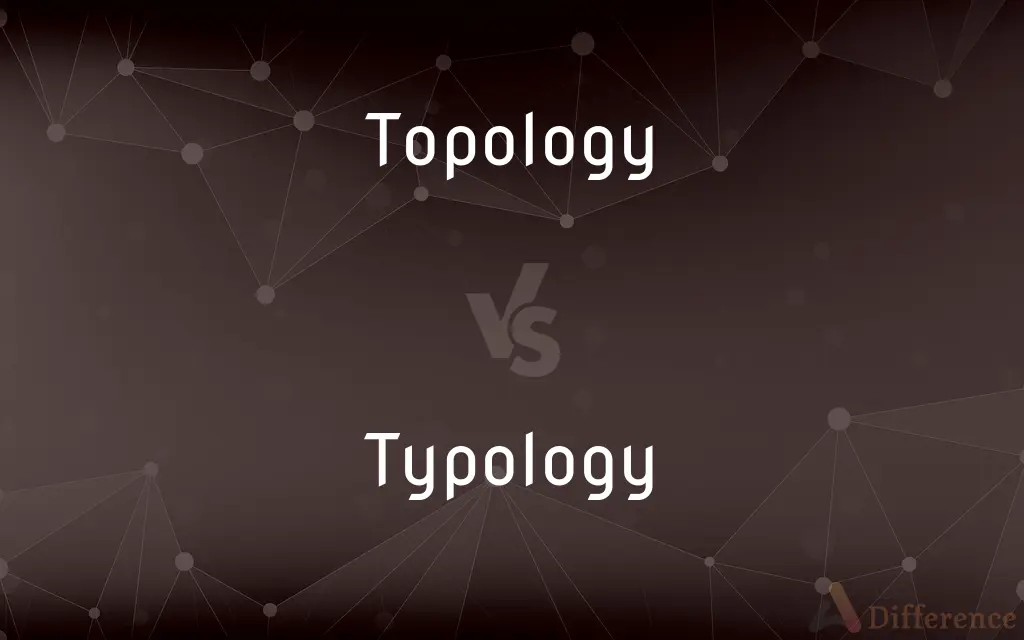Topology vs. Typology — What's the Difference?
Edited by Tayyaba Rehman — By Urooj Arif — Updated on March 1, 2024
Topology studies properties of space that are preserved under continuous transformations, while typology categorizes objects or concepts based on common characteristics.

Difference Between Topology and Typology
Table of Contents
ADVERTISEMENT
Key Differences
Topology is a branch of mathematics focusing on the properties of space that are preserved under continuous deformations, such as stretching, crumpling, and bending, without tearing or gluing. It deals with the qualitative aspects of space, examining how geometric objects are fundamentally related. Typology, on the other hand, is a method of classification based on the identification of common characteristics among a set of objects or concepts, often used in fields like archaeology, linguistics, and architecture.
The concept of continuity plays a central role, enabling the study of spaces and shapes in a way that abstracts from the exact distances and angles. This approach allows topologists to classify spaces according to properties like connectivity and compactness. Typology, however, focuses on grouping entities based on shared attributes or patterns, facilitating the analysis and understanding of their underlying structures or functions.
Topology emerged from geometry and set theory, seeking to understand the intrinsic nature of spaces, typology has its roots in the study of categorizing various types of objects, whether they are physical artifacts, linguistic elements, or architectural forms. The aim of topology is to explore the conceptual underpinnings of space itself, whereas typology aims to create systematic frameworks for analysis and comparison.
Topology uses concepts like homeomorphisms to determine when two spaces are equivalent, focusing on their form and structure rather than their specific measurements. Typology, conversely, relies on qualitative and quantitative characteristics to establish categories or types, often leading to hierarchical or taxonomic structures.
Despite their distinct focuses, both topology and typology offer frameworks for understanding complexity. Topology provides a mathematical foundation for analyzing spaces in a broad, abstract sense, while typology offers a systematic approach for classifying and understanding diversity within and across various fields.
ADVERTISEMENT
Comparison Chart
Definition
The mathematical study of properties that are preserved under continuous transformations.
The study and classification of things based on common characteristics.
Main Focus
Properties of space and shape, such as connectivity and continuity.
Categorization and analysis of objects or concepts based on shared attributes.
Application Fields
Mathematics, physics, computer science.
Archaeology, linguistics, architecture, sociology.
Key Concepts
Continuity, homeomorphism, compactness.
Categories, classification systems, typological analysis.
Purpose
To understand the intrinsic properties of spaces and shapes.
To organize and analyze objects or concepts based on type.
Compare with Definitions
Topology
The mathematical foundation for understanding connectivity and boundary.
Topology can determine whether a space is simply connected or not.
Typology
A systematic method of grouping entities within a field of study.
Linguistic typology examines languages based on their syntactic and grammatical properties.
Topology
The study of how geometric shapes can be continuously transformed into each other.
Topology explains why a knot cannot be untied without cutting.
Typology
A framework for understanding diversity through classification.
Typology helps in identifying different species of plants based on shared characteristics.
Topology
The exploration of continuous functions and their implications.
Topology investigates how a rubber band stretched over a newspaper page can still be considered the same shape.
Typology
The classification of objects or concepts based on common characteristics.
Typology in archaeology categorizes ancient tools by their use and form.
Topology
A branch of mathematics concerned with the properties of space preserved through deformation.
A donut is topologically equivalent to a coffee cup because one can be transformed into the other without cutting or gluing.
Typology
The organization of information into types for easier analysis and understanding.
Architectural typology groups buildings by style, function, and form.
Topology
The analysis of spaces independent of their metric properties.
Topologists classify surfaces based on their number of holes.
Typology
The study of patterns and categories within specific disciplines.
Typology in sociology might classify societies based on their social structures.
Topology
In mathematics, topology (from the Greek words τόπος, 'place, location', and λόγος, 'study') is concerned with the properties of a geometric object that are preserved under continuous deformations, such as stretching, twisting, crumpling, and bending; that is, without closing holes, opening holes, tearing, gluing, or passing through itself. A topological space is a set endowed with a structure, called a topology, which allows defining continuous deformation of subspaces, and, more generally, all kinds of continuity.
Typology
A classification according to general type, especially in archaeology, psychology, or the social sciences
A typology of Saxon cremation vessels
Topology
The study of geometrical properties and spatial relations unaffected by the continuous change of shape or size of figures.
Typology
The study and interpretation of types and symbols, originally especially in the Bible.
Topology
The way in which constituent parts are interrelated or arranged
The topology of a computer network
Typology
The study or systematic classification of types that have characteristics or traits in common.
Topology
Topographic study of a given place, especially the history of a region as indicated by its topography.
Typology
A theory or doctrine of types, as in scriptural studies.
Topology
The branch of mathematics dealing with those properties of a geometrical object (of arbitrary dimensionality) that are unchanged by continuous deformations (such as stretching, bending, etc., without tearing or gluing).
Typology
The study of symbolic representation, especially of the origin and meaning of Scripture types.
Topology
Topographic study of a given place (especially the history of place as indicated by its topography);
Greenland's topology has been shaped by the glaciers of the ice age
Typology
A discourse or treatise on types.
Topology
The configuration of a communication network
Typology
Classification according to general type
Common Curiosities
What is the primary goal of topology?
To study properties of spaces that remain unchanged under continuous transformations, providing insights into the fundamental nature of geometric forms.
Why is typology important in fields like archaeology?
It helps in organizing and understanding ancient artifacts by categorizing them into types, which can shed light on their usage, cultural significance, and historical context.
How do typology and topology approach the concept of similarity?
Topology looks at similarity in terms of properties preserved under continuous transformations, while typology considers similarity based on shared characteristics or attributes.
How does typology differ from topology?
Typology is the classification of objects based on common characteristics, while topology is a mathematical study of spatial properties preserved under deformation.
Can topology be applied to real-world problems?
Yes, topology has applications in areas like network theory, cosmology, and material science, among others.
What role does topology play in computer science?
Topology is crucial in areas like data analysis, network theory, and algorithm design, influencing how data structures and networks are conceptualized and optimized.
How does typology aid in linguistic studies?
By categorizing languages based on grammatical structures or syntactic features, helping in the comparative study of languages and understanding language evolution.
How does typology impact architectural design?
It influences design decisions by providing architects with a framework of established types, which can guide the creation of buildings that fulfill specific functional or aesthetic criteria.
What is the significance of continuous functions in topology?
Continuous functions are essential in topology as they allow the transformation of spaces without losing their intrinsic properties, enabling the classification of spaces based on these transformations.
Is typology only used for physical objects?
No, typology can also classify concepts, linguistic elements, and other non-physical entities based on common features.
What is a homeomorphism in topology?
A homeomorphism is a continuous, bijective function between two topological spaces that has a continuous inverse, showing a fundamental equivalence between the spaces.
What is a compact space in topology?
A compact space is a type of topological space where every open cover has a finite subcover, reflecting a property of being "contained" or "bounded" in a topological sense.
How are new typologies developed?
Through rigorous study and analysis, often involving the identification of patterns, anomalies, and commonalities among a set of objects or concepts.
Can typology be subjective?
While it aims to be systematic, the classification in typology can sometimes be influenced by subjective decisions regarding which characteristics are deemed significant for categorization.
Can the principles of typology be applied across different fields?
Yes, the principles of typology are versatile and can be applied across various disciplines to classify and analyze a wide range of objects and concepts based on shared characteristics.
Share Your Discovery

Previous Comparison
Polenta vs. Ugali
Next Comparison
Nebula vs. SupernovaAuthor Spotlight
Written by
Urooj ArifUrooj is a skilled content writer at Ask Difference, known for her exceptional ability to simplify complex topics into engaging and informative content. With a passion for research and a flair for clear, concise writing, she consistently delivers articles that resonate with our diverse audience.
Edited by
Tayyaba RehmanTayyaba Rehman is a distinguished writer, currently serving as a primary contributor to askdifference.com. As a researcher in semantics and etymology, Tayyaba's passion for the complexity of languages and their distinctions has found a perfect home on the platform. Tayyaba delves into the intricacies of language, distinguishing between commonly confused words and phrases, thereby providing clarity for readers worldwide.
















































